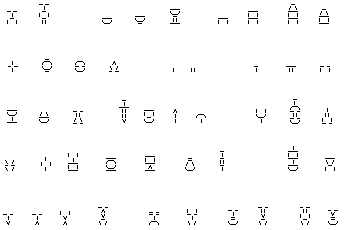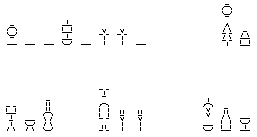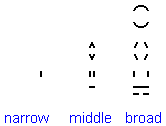
This ideogram means ' face' - and also it represents the
pronunciation 'ela'
For it is composed of specially designed letters.
If you read these letters from bottom to top, the phonetic result is 'ela' :
Phonetic Picture-Writing: a letter-picture-writing
What is a Phonetic Picture-Writing ?
A phonetic picture-writing is a picture-writing, which also is a true phonetic writing.
For its ideograms (picture symbols) are composed of special letters. An example:

|
|

A simple Phonetic Picture-Writing
Here we show a simple, but quite efficient phonetic picture-writing. It has
only these 12 letters (3 of them contained in the above ideogram for "face"):

(Red letters describe the pronunciation by international phonetic writing.
h is a shortening for the sound "sh")
One can bring into one's mind this alphabet by 5 ways: Just learn it. Or learn
the system of this mini-alphabet (see below). Or learn a few words (the ideogram
and the pronunciation): If you, for example, know the 5 words for 'face', 'two',
'circle', 'square' and 'rhomb' shown below, you know the whole alphabet of this picture-writing.
Or print the letters
(including their phonetic transcription), cut them out and lay words with them.
Or type in words on screen.
Examples of Words

The words above can be spoken easily. For all syllables only consist of
consonant + vowel, e.g. 'me' or 'la'. (At the beginning of the words, also
the syllables 'e', 'a', 'o' may occur.) But what can one do, if an
ideogram is an unspeakable series of letters, e.g. 'fp' ?
To solve the problem consequently, and to yield a very clear and nice-sounding
pronunciation, there is help: when speaking an ideogram, you insert as often
the vowel 'i' and the consonant 'j' (spoken like the y in 'yes'),
until the resulting word has only syllables consisting of consonant + vowel.
(But the syllables 'e', 'a', 'o' at the beginning of a word
are not changed - they can be pronounced easily). These i / j are not written,
there are no letters for them. Thus, the ideogram 'fp' is spoken as 'fipi',
the ideogram 'taa' as 'taja'. Examples:







More examples of words in the printable dictionary
and in the interactive dictionary
Letter Size
For didactic reasons, we figured the phonetic picture-writing rather big. But
its simply shaped letters may be reduced much in size, more than Latin letters.
Then they appear more charming and not so bulky, also more realistic:
one scarcely has the impression that details are missing. (Also gray instead of
black colour lets ideograms look more impressionistic, also bigger distance between the letters.)
Some smaller ideograms:

Printed by laser or by types, the ideograms are more clear than
on a screen. (If using an inkjet printer, the lines become too broad and thus
the distances between lines become too small - the letters become indistinct at
this size.) Here some pictures of scenes, explained in the article about grammar:

Purpose
The original purpose of a phonetic picture-writing is: it's an artificial language,
by which one can express everything - optically and acoustically.

| For ideograms can be combined into scenes, and these can be spoken as sentences: This example is pronounced ani amimipi ela and means "legs, (over it) cape, (over it) face": "There is a standing man, with cape, his face is visible." |
Different Versions
The simple phonetic picture-writing presented above contains the 12 most useful signs,
and the sounds are attached very systematically to the signs. It's already very efficient.
But to yield a full speach, more signs are necessary: 25 letters seem
to be the mininum, to be able to portray all kinds of things and ideas by
good ideograms.
During the antiquity, different versions of phonetic picture-writing have
been used. Often the difference was only an other attachment of sounds
to the signs, e.g. to exchange the humming for the hissing consonants, and vice versa.
By this way, mystical circles tried to delimit from other such circles,
and the "upper class" in greater mystical circles tried to delimit from
the "ordinary people".
The System of Letters

In the picture beside we arranged the 12 letters so, that you recognize at once:
There are narrow, middle-broad and brod signs.
Below again the 12 letters, now arranged in a 4 * 3 matrix.
You see: Similar sounds are represented by similar letters.
Signs for vowels are flat, signs for consonants are high.
For every (in writing direction) broadening sign there is a similar, narrowing sign.
By turning down the one, you get the other one.

- All signs for vowels ( e a o ) are horizontal lines
It works like a chord: the longer it is, the deeper the sound
- All signs for humming consonants ( l n m ) are vertical lines
What is a humming sound? If you touch your larynx, or put a small
finger into an ear, and speak a humming sound, you feel vibrations.
Vowels also hum. So it is generally true:
Humming sounds are written by straight lines, parallel to a
coordinate axis. Not humming sounds are written by other lines:
- All signs for hissing sounds ( s h f ) broaden on top
They symbolize emitting, broadening air
- All signs for stopping sounds ( t k p ) narrow on top
What is a stop (or plosive)? An interrupted sound: if you speak, for example, slowly
the word "apa", somewhen during it there is silence. Then air is emitted explosively
Another memory-aid: If you remove the curves from the Latin lower case letters l,n,m
(from m also remove the central vertical line), you receive the corresponding
letters of the phonetic picture-writing presented in this article. You get the same
result, if you remove all non-vertical lines from the Latin upper case letters L,N,M.
Also Latin K and P resemble the corresponding letters of our picture-writing,
if you now remove the vertical lines and turn the result by 90 degrees.
More Themes
Non-bold links indicate pages in German language. (I'm sorry I had no time to translate them.) Nevertheless, pictures on these sites often will give you a good idea of the content.
Interactive programs:
Type words
Type sentences
The phonetic-picture letters for printing, cutting out, laying words
Dictionary (interactive) 1052 words
Dictionary (printable) 220 words
Dictionary (big, printable) 1590 words, below at downloads
Phonetic picture-writing: Frequent questions
Advantages of phonetic picture-writing
Grammar:
Grammar: the image (sentence)
Grammar: writing 2 words one above the other
Grammar: direction and perspective
Grammar: 3-dimensional models
Gammar: multiple perspective
Grammar: inserted images
Phonetic picture-writing and molecule grammar
Formal grammar of phonetic picture-writing (for specialists)
Versions of phonetic picture-writing:
Extensions of the 12-letter picture-writing part 1
Extensions of the 12-letter picture-writing part 2
A phonetic picture-writing with 16 letters
A phonetic picture-writing with 20 letters
A phonetic picture-writing with 20 letters (other version)
Thereby formed words (ideograms) of the subjects:
Astronomy
mathematics
Buildings
Visual Arts
Religion
A syllable writing with 28 signs
A syllable writing with 80 signs
The antique standard phonetic picture-writing
The firstly published versions of phonetic picture-writing
Typifying:
Kinds of phonetic picture-writings
Point writings
Bar writings
Overwriting of signs
Forming signs for phonetic picture-writings
The letter field of phonetic picture-writing
Symbolic numbers for phonetic picture-writing
History:
History of phonetic picture-writing
Quotations of antique authors about phonetic picture-writing
Quotations of antique authors about encoding pictures
Pictures encoded in texts
Pictures encoded in texts of the antique writer Pliny (Plinius)
Pictures encoded in texts of the antique writer Pliny, part 2
Encoded self-portrait of Pliny
Latin writing as a helping phonetic picture-writing
Latin words in phonetic picture-writing
Greek writing as a helping phonetic picture-writing
General language theorie (linguistics):
Design principles for artificial languages
A clear, nice sound system for artificial languages
Forming words
Design principles for a grammar
Molecule grammar
Alphabetic sorting
Alphabetic sorting of numbers, numerical correctly
A finger-spelling system interesting
Language and psyche
Writing and intuition
Evaluation of some writings by intuitive correctness
lautbildschrift-16-buchstaben.ttf (4 KB) Phonetic picture-writing with 16 letters, vektor-font (for all WINDOWS text-programs) laut16bu.fon (2 KB) Phonetic picture-writing with 16 letters, bitmap-font (usable in text-programs NOTEPAD (new), WORDPAD (old), not in WORD) lantik12.fon (4 KB) Antique phonetic picture-writing with 12 letters, bitmap-font (usable in text-programs NOTEPAD (new), WORDPAD (old), not in WORD) Simply view antique text by NOTEPAD and select this writing ! lautbildschrift-dokumentvorlage.doc Document pattern and instructions for using phonetic picture-writing in texts (29 KB, WORD - format) lautbildschrift-lexikonvorlage.doc Dictionary pattern for words of phonetic picture-writing (32 KB, WORD - format) lautbildschrift-lexikon.doc Dictionary (98 pages, about 1590 words, 1703 KB, WORD-Format)
Author and inventor: Leonhard Heinzmann email Homepage This site also can be reached via www.lautbildschrift.de FREE COPYRIGHT for this article! update: 2013-8-9 The phonetic picture-writing is free for everybody and not subject to any rights or patents